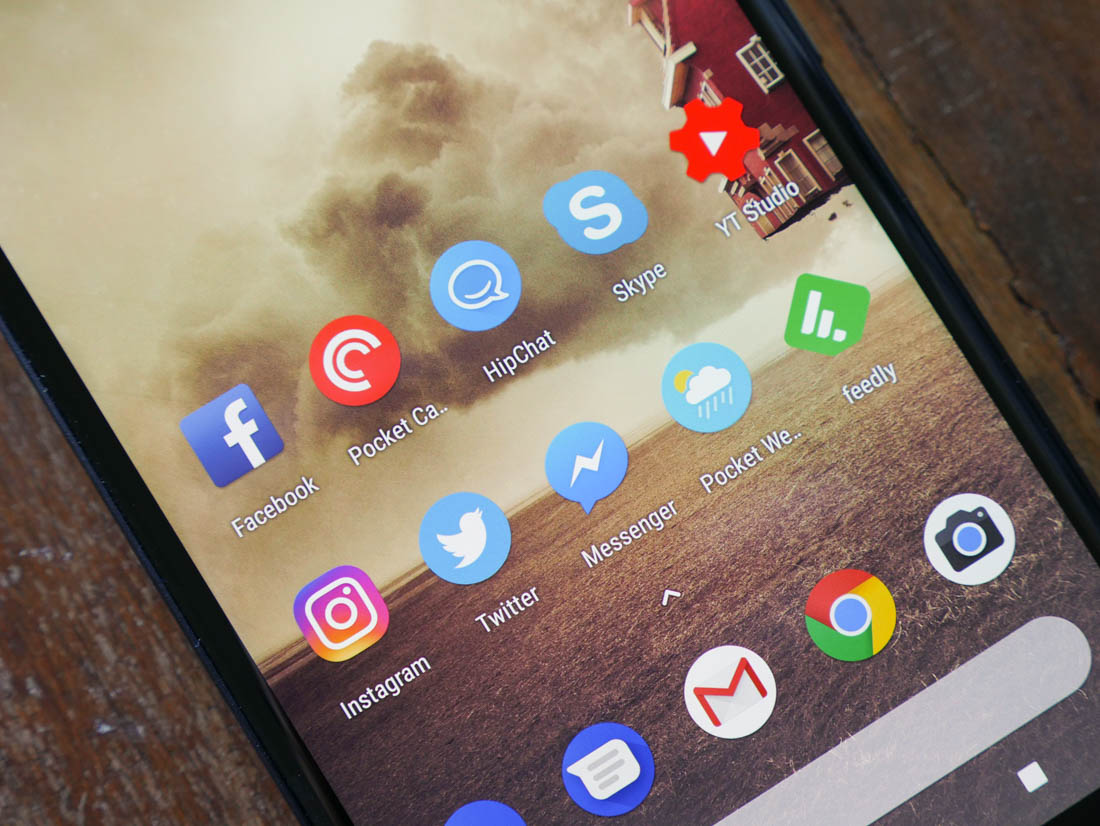Oppo A5s Full Specifications
Oppo recently launched the A5s

| NETWORK | |
|---|---|
| Technology | GSM / HSPA / LTE |
| 2G bands | GSM 850 / 900 / 1800 / 1900 - SIM 1 & SIM 2 |
| 3G bands | HSDPA 850 / 900 / 2100 |
| 4G bands | LTE band 1(2100), 3(1800), 5(850), 7(2600), 8(900), 20(800), 28(700), 38(2600), 40(2300), 41(2500) |
| Speed | HSPA 42.2/5.76 Mbps, LTE-A (2CA) Cat6 300/50 Mbps |
| GPRS | Yes |
| EDGE | Yes |
| LAUNCH | |
|---|---|
| Announced | 2019, March |
| Status | Available. Released 2019, April |
| BODY | |
|---|---|
| Dimensions | 155.9 x 75.4 x 8.2 mm (6.14 x 2.97 x 0.32 in) |
| Weight | 170 g (6.00 oz) |
| SIM | Dual SIM (Nano-SIM, dual stand-by) |
| DISPLAY | |
|---|---|
| Type | S-IPS LCD capacitive touchscreen, 16M colors |
| Size | 6.2 inches, 95.9 cm2 (~81.6% screen-to-body ratio) |
| Resolution | 720 x 1520 pixels, 19:9 ratio (~271 ppi density) |
| Protection | Corning Gorilla Glass 3 |
| PLATFORM | |
|---|---|
| OS | Android 8.1 (Oreo); ColorOS 5.2 |
| Chipset | Mediatek MT6765 Helio P35 (12nm) |
| CPU | Octa-core (4x2.3 GHz Cortex-A53 & 4x1.8 GHz Cortex-A53) |
| GPU | PowerVR GE8320 |
| MEMORY | |
|---|---|
| Card slot | microSD, up to 256 GB (dedicated slot) |
| Internal | 32/64 GB, 2/3/4 GB RAM |
| MAIN CAMERA | |
|---|---|
| Dual | 13 MP, f/2.2, AF 2 MP, f/2.4, depth sensor |
| Features | LED flash, HDR, panorama |
| Video | 1080p@30fps |
| SELFIE CAMERA | |
|---|---|
| Single | 8 MP, f/2.0 |
| Features | HDR |
| Video | |
| SOUND | |
|---|---|
| Loudspeaker | Yes |
| 3.5mm jack | Yes |
| Active noise cancellation with dedicated mic | |
| COMMS | |
|---|---|
| WLAN | Wi-Fi 802.11 b/g/n, Wi-Fi Direct, hotspot |
| Bluetooth | 4.2, A2DP, LE |
| GPS | Yes, with A-GPS, GLONASS, GALILEO, BDS |
| Radio | FM radio |
| USB | microUSB 2.0, USB On-The-Go |
| FEATURES | |
|---|---|
| Sensors | Fingerprint (rear-mounted), accelerometer, proximity, compass |
| Messaging | SMS(threaded view), MMS, Email, Push Email, IM |
| Browser | HTML5 |
| BATTERY | |
|---|---|
| Non-removable Li-Ion 4230 mAh battery | |
| MISC | |
|---|---|
| Colors | Red, Black, Gold, Green |
| Models | CPH1909 |
Oppo A5s Full Specifications
Asus ROG Phone 2 Gaming Review: A Gamer’s Delight!
Can it change the perception of a gaming smartphone? Let’s find out.
Asus recently took the wrap off from its latest gaming smartphone, the ROG Phone 2. The smartphone comes with a price tag of Rs 37,999 for the 8GB RAM variant, while the 12GB RAM option is priced at Rs 59,999.
The ROG Phone 2 is designed to impress the gaming community with its key features. The smartphone comes loaded with top-notch hardware coupled with an immersive display. The phone is a first in India to sport a 120Hz refresh rate along with 240ms response time. This coupled with other gaming-centric features and aggressive pricing strategy, the ROG Phone 2. Can it change the perception of a gaming smartphone? Let’s find out.
Asus ROG Phone 2 is a true gaming beast when it comes to specifications. The smartphone is backed by a 6.59-inch Full HD+ AMOLED display with a screen resolution of 2340 x 1080 pixels. Like we said at the start, the smartphone is the first to sport a 120Hz screen refresh rate with 240Hz touch response time. The display features 108 per cent DCI-P3 colour gamut and it also supports 10-bit HDR. This simply means that the gaming experience will be a pleasurable one with this smartphone.
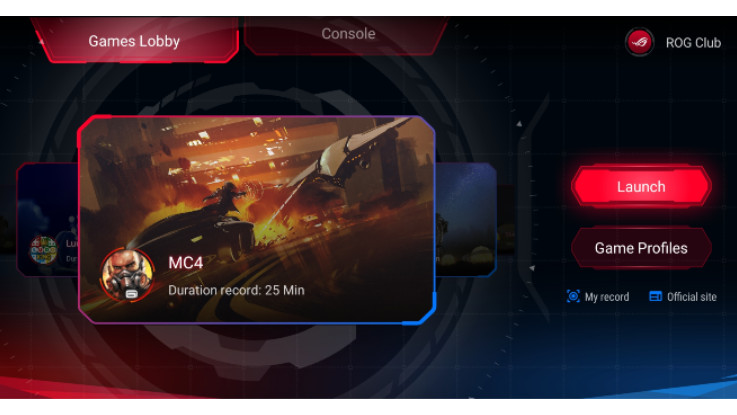
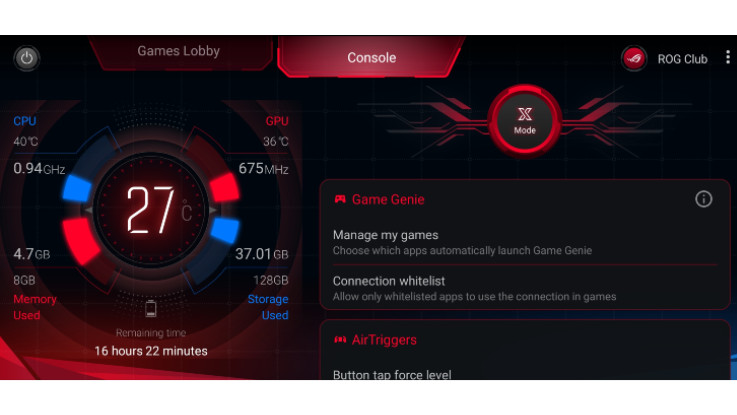
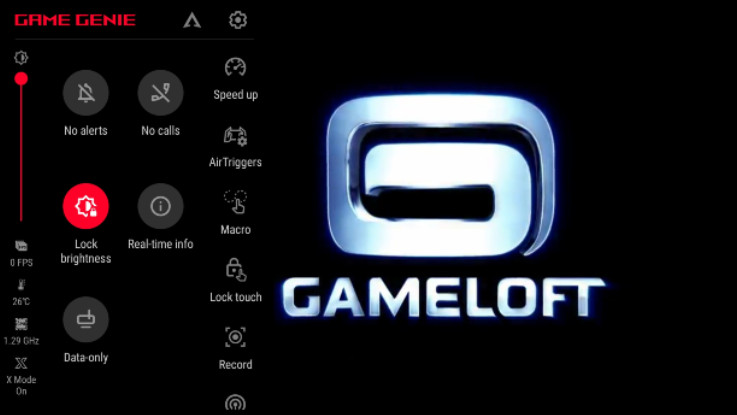
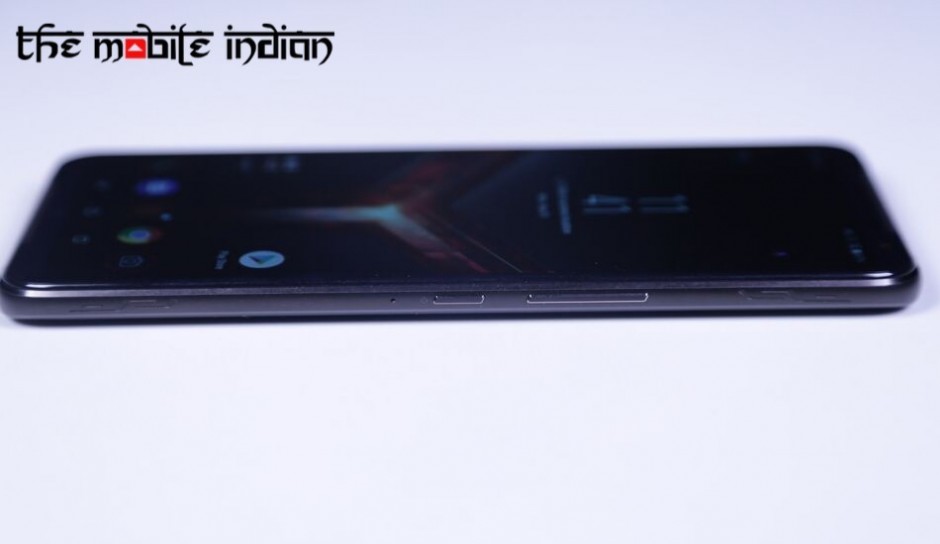
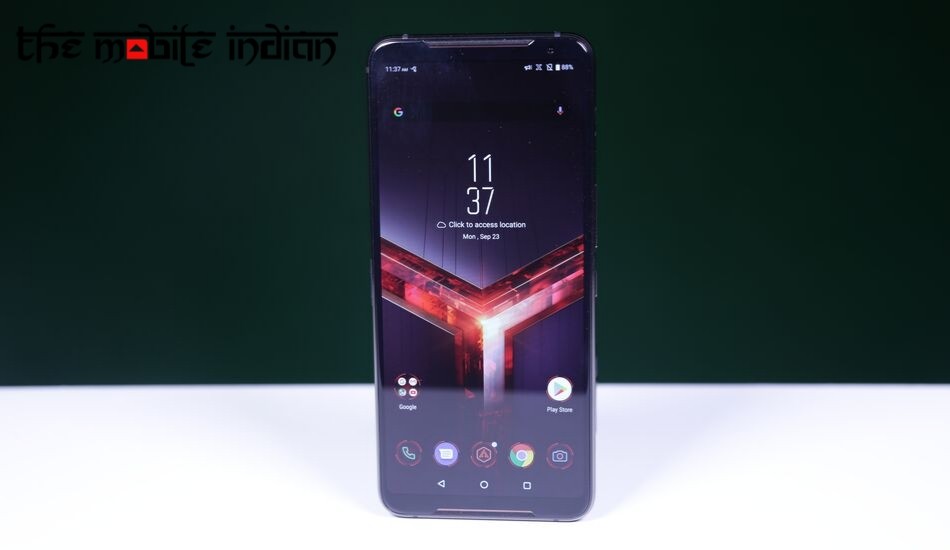
Coming to the hardware, the ROG Phone 2 is powered by the latest Qualcomm Snapdragon 855+ processor along with Adreno 640 GPU. The phone is backed by up to 12GB of RAM and up to 512GB of internal storage. The company has also added AirTriggers II that comes with remappable buttons at the right side of the device. For heat management, the company has added vapour cooling chamber, heat dissipation plate and vents. It also features dual haptic actuators for 3D feedback.
Armoury Crate and Game Genie enhances gaming experience!

Asus has added an Armoury crate application, which acts as a gaming hub for the smartphone. The moment you open the application, you will be greeted with ROG logo animation, which looks cool. Coming to the application, it comes with two sections Games Lobby and Console.
Let’s start with the Console. The left side of the screen shows real-time usage of CPU, GPU. RAM and storage. The company has introduced a new X Mode, which increases the clock speed for a better gaming experience. The app also allows users to control the sensitivity of Air Triggers and it also helps in controlling the System Lighting. Users can customise Aura Sync Lighting according for different scenarios like Music, Screen on, Boot Up, Incoming Call, During Call, Games, Notifications and more.

Now, let’s move to Game Lobby. This section shows all the games you have on the smartphone. The company has given an option of Game Profile through which you users can customise various settings for that game. One can change the performance settings, display settings, touch sensitivity, audio and network. This comes handy if you want to tweak the settings before playing the game and we liked the fact that it can be customised with so many options.

Moving on, the ROG Phone 2 is loaded with Game Genie, which can be accessed by swiping left during the game. The Game Genie is a one-stop for all gaming-related things. You have an option to lock brightness, restrict notifications and calls during gameplay. If you are facing a slight lag, you can tap on Speed up option, which frees the RAM and dedicate the resources to the game. Furthermore, one can customise the position of AirTriggers through this app. It also features an option to record the game and it also gives you an option to choose between recording game audio, microphone and more.
Gaming is a delightful experience!
The Asus ROG Phone 2 is a gamer’s delight in true sense. The vivid AMOLED screen coupled with the latest hardware takes the gaming experience to the next level. We played some casual games for starters like Alto’s Odyssey, Stack Ball and Dancing Road on this smartphone and it handled like a piece of cake.

Coming to high-end games, we played PUBG Mobile, Modern Combat 4 and Asphalt 9. To start with PUBG Mobile, it took High settings as default. During the gameplay, we didn’t notice any lag or stuttering at all. The game was running at a stable 60fps and the whole gameplay was quite smooth in our opinion. When we pushed the graphics to HDR with extreme frame rate and colourful theme, the results were simply breathtaking. The visuals came out to be quite immersive and the overall gameplay was solid.
Coming to heat management, we noticed that with two or odd matches in PUBG Mobile, the lower part and left edges of the phone was overheated and it reaches a certain limit where it was a bit difficult to hold in your hand. This happens primarily because with such high settings, the phone requires a lot of computing power. But still, we think the overheating problem could have been managed slightly better.

Coming to Asphalt 9, the whole gaming experience was quite immersive and we did enjoy the racing and graphics were at the maximum. The smartphone features dual speakers, which are quite loud and overall audio quality it to the point, making a delightful experience while playing the racing game. Moving on, with Modern Combat 4, the AirTriggers were helpful as we assigned them for shooting and aiming. The AirTriggers default sensitivity is a bit hard, so a light press does register an impress. However, you can change in the Console section of the Armoury Crate application. The only downside we noticed is the size of the device and the fact that it is heavy. So, if you are playing games for an extended period, your hands will start aching after a while.
Asus ROG Phone 2 Gaming Review: A Gamer’s Delight!
Posted by : Admin
SMARTPHONES Google Pixel 2 XL
The Best Phones You Can Buy, From $200 to $1,000+

There has been no shortage of controversy around Google's latest phone, the Pixel 2 XL since it launched less than a month ago. While initial reviews painted the Pixel 2 line in a highly positive light, days later, the Pixel 2 XL’s display was dominating discussion around the internet. Problem after problem kept appearing, ranging from poor viewing angles to burn in, with Google scrambling to respond.
With the display blunder evolving at rapid pace and some kind of response expected at any moment, I decided to hold off on publishing my review of the Pixel 2 XL until the situation had settled. This also gave me more time to analyse the phone, in particular its display, and present my opinion based on facts. So if you want the full verdict on why the Pixel 2 XL’s display is not up to scratch, and what (if anything) can be improved with software, check out the display section further down this page.
But aside the phone’s display, there’s a lot of great technology packed into the Pixel 2 XL. This phone is genuinely close to being the perfect Android device that it’s painful to see its display holding it back from perfection. I still think that the Pixel 2 XL is a phone you should consider buying.
Let’s talk basics first.
The Pixel 2 XL has a 6.0-inch 1440 x 2880 p-OLED display with narrow bezels: the first and only phone in Google’s line-up with an impressive screen to body ratio. It’s powered, unsurprisingly, by the Snapdragon 835 SoC, 4GB of RAM and either 64 or 128 GB of internal storage. There’s a 12.2-megapixel camera on the rear with an f/1.8 lens and OIS, combined with an 8-megapixel sensor on the front. And the battery? 3520 mAh.
All this hardware has led to a very expensive smartphone, too. The Pixel 2 XL starts at $849 outright for the 64GB model, or a whopping $949 if you want the 128GB model. You’re essentially paying an extra $200 for the larger display, as the smaller Pixel 2 packs near-identical hardware for $649.
Design
On the design front, there’s no doubt the Pixel 2 XL is the best-looking handset ever released by Google. I thought last year’s Pixel was ugly, with fat bezels and an awkward glass slab on the rear. The Nexus 6P that came before it wasn’t much better. The Pixel 2 XL is a far more refined handset though.
Yes, there is still the distinctive glass slab on the rear, but it’s much better integrated into the design. The metal body feels excellent in your hands, and the matte coating makes it easy to grip. The edges are rounded on all sides, the seams between glass and metal on the front are tight, and in general this phone fits in the hand well. Plus, it just has that premium touch with a pleasant, modern, minimalist aesthetic that fits with Google’s design strategy of late.
The Pixel 2 XL is reserved on the rear, but it’s all party on the front. The 6.0-inch 18:9 OLED occupies most of the usable space, with a decent 76.4% screen to body ratio. Google has ticked all the boxes from a design perspective and even though the bezels aren’t as small as competitors like the iPhone X and Galaxy Note 8, we like it.
As a stickler for detail, I did note the bezel is not even; it’s 8.5mm on the bottom, and 12mm on the top, which makes the display look misaligned on the front panel. It’s one of those things that you can’t unsee when you first see it, so a note to Google here: perfect symmetry is best.
On the positive side, Google (or is it LG?) managed to cram stereo front facing speakers into the chassis, which makes it great for content consumption and gaming. The speakers are loud and decent for a smartphone.
While Google has included front-facing speakers, they’ve removed the headphone jack, which I personally dislike. There is still no good reason why a phone can’t include both a 3.5mm audio jack and USB-C. You can still connect wireless headphones and USB-C headphones to a phone that has both USB-C and 3.5mm audio. Plus the whole USB-C to 3.5mm audio dongle situation is a garbage fire. I’m disappointed Google felt the need to make such a decision. Headphone ecosystem lock-in is becoming a real thing and that’s such a shame.
It's no surprise the Pixel 2 XL has a fingerprint sensor on the rear, which has been standard for Google’s last three phone generations. It’s in the perfect position for easy use and in my opinion trumps many other fingerprint unlock implementations or face identification technology at this stage.
The Pixel 2 XL is water resistant, which is another necessary inclusion. Water resistance is one of those features that is basically required for a top-end smartphone these days. Don’t use the Pixel 2 XL in saltwater though.
If you’re wondering about whether the Pixel 2 XL or Pixel 2 is easier to hold and use, that crown does go to the smaller Pixel 2. Despite this, I had no trouble holding or operating the Pixel 2 XL and its large display, even in one hand. The screen is expansive but the small bezel size assists with usability.
As for more minor concerns, the camera does protrude slightly from the body, which could make it prone to scratching after a lot of typical use. There’s no microSD expansion, which is typical of Google smartphones, though it would have been a nice inclusion considering adding an extra 64GB of internal storage costs $100.
Display: Hardware Issues
The most contentious aspect of the Pixel 2 XL is its display. Google has used an LG p-OLED panel (6.0", 2880 x 1440, 18:9 ratio), so it comes with all the associated benefits and issues with a taller aspect ratio. 16:9 videos, for example, will be shown with pillarboxing unless you zoom in the video. The good news is that most popular applications do a great job of supporting the extended aspect ratio these days.
Before discussing the issues with the Pixel 2 XL’s display, I wanted to touch on some of the more basic properties and the things Google did correctly. As we’re looking at OLED technology, the panel has essentially infinite contrast and deep blacks; deeper than any LCD can provide. The advantage is colors pop more than an LCD, and the display uses less power to produce blacks. On top of this, OLED panels are thinner, so the phones themselves can be thinner.
OLEDs also tend to have lower persistence and shorter pixel response times than LCDs, which makes them more suited to VR applications. Daydream VR is a key pillar of Google’s Android and Pixel strategies, so it made sense for them to go OLED.
In some aspects, the display is pretty similar to other OLEDs. Due to its high pixel density (538 ppi) it uses a diamond subpixel arrangement, which has lower ‘true’ detail than the RGB stripe used in LCDs. This isn’t a big deal at this sort of pixel density. Brightness is fairly typical as well, at 437 nits (100% APL). Samsung’s flagship phones push higher than this with their sunlight modes, but most other OLED smartphones do not and tend to fall around the acceptable 400 nit mark. The Pixel 2 XL is not hard to view outdoors.
What is clear, though, is that LG’s mobile OLED display technology is several generations behind Samsung, who is the market leader. There are several fundamental hardware issues with this panel – issues that Samsung has solved through years of tech refinement – which cannot be resolved through software updates.
Viewing the Pixel 2 XL straight on with a full white screen...
The first issue is the biggest: awful viewing angles. Even the slightest deviation produces a noticeable blue tint, such that you need to be viewing the display dead-on to receive an ideal experience. I’m not 100% sure whether this is an issue with the panel itself, or some other aspect to the display composition like a filter or other layer, but it’s a hardware problem, and it’s immediately obvious. Samsung solved this problem a long time ago, so LG needs to work hard to resolve this with their technology in the very next generation.
...and viewing it on an angle
Uniformity is an issue too. This isn’t something I normally discuss in any smartphone review, because most OLEDs and LCDs are relatively even. The Pixel 2 XL’s OLED has noticeable areas that are yellower/redder than others; on my review unit, the middle section is a slight too red relative to the top and bottom. This is most noticeable when the display is using a white background. I’ve seen some units that have worse uniformity than my display, too.
LG’s OLED technology is grainer than Samsung’s, too, which is a unique problem I haven’t seen with many LCDs either. The grain presents itself as a slight speckling, almost dust-like, across the entirety of the display. It’s most noticeable at a lower brightness and while viewing uniform white colors, like viewing the background of the Gmail or Twitter apps. Not as much of an issue in my opinion as the viewing angles or uniformity, but with the grain, the display doesn’t feel as crisp or clear as most other flagship phone displays.
The last hardware issue that has seen widespread reports is burn in/image retention. My unit started suffering from this after about 4 days of usage, and it’s only become worse after a few weeks. When viewing a full grey image, the outline of the navigation bar can clearly be seen. On the Pixel 2, which uses a Samsung OLED, burn in is practically invisible.
I tried to reduce the burn in using a range of techniques such as cycling through a range of colors for hours, but this only had a minor effect on the visibility of the burned in areas. I’ll have to see how this plays out over time, as the display will degrade further with more use. The good news is the latest software update from Google does include some techniques that will help mitigate the burn-in over time.
So what can you do about the Pixel 2 XL’s display hardware issues? Well, not much. These are all inherent issues with the hardware itself, so it’s not something that can be resolved entirely through software. I will say, though, that on day to day usage the only really noticeable issue is the poor viewing angles. Unless you are looking closely and trying to pick out specific problems, you won’t notice the uniformity and grain issues on a daily basis.
SMARTPHONES Google Pixel 2 XL
Posted by : Admin
Best WordPress hosting services 2020 in the table below. Logo Plan Price/ month Features Support View Full Review Basic $2.95/mo. 1...














